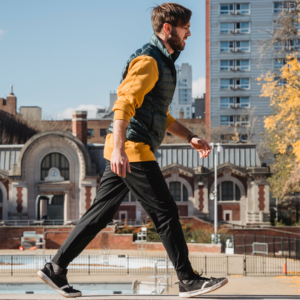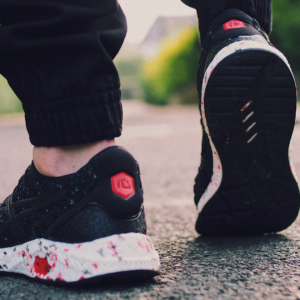Whether your goal is to walk 8,000 or 10,000 steps during your power walk, incorporating these five tips can provide an extra boost if you’re looking to shed those extra pounds you gained from being less active during the winter months.
Weighted Vest

A weighted vest can help burn extra calories by making your muscles work harder, toning your abdomen muscles, and improving your cardio routine by giving your heart a better workout.
For most people, a weighted vest weighing no more than ten percent of their body weight is a good place to start. So, if your weight is around 150 pounds, you can begin with a 7-12 pound vest. If you have never used one, it may be a good idea to wear 5 percent of your body weight and work up to 10.
If you notice you’re having trouble finishing your walk or experiencing any pain, you can decrease the weight in your vest.
Reduce the weight by two to three pounds, ensuring the weight is evenly distributed on both front and back.
If you continue to feel any pain and are still not able to walk the exact amount you’re used to, stop using the vest. It’s not helping you.
Walking Sneakers

While there’s no evidence that a specific sneaker can help you lose weight, having the right fit will increase your ability to get more steps in and increase the time you walk by keeping your feet comfortable.
Most people don’t realize that the pain in their lower backs, knees, ankles, and other foot problems may not be from the hard pavement but rather from walking with poorly fitting sneakers.
Switching to the right-fit sneaker increased my daily walks from 30 to 60 minutes! It didn’t happen overnight, but I immediately noticed a change in my body’s feel and endurance.
Uphill vs. Flat

Add an uphill walk to your routine whenever possible. It’s a low-impact cardio workout that elevates your heart rate and burns more calories than walking on flat ground.
It helps to keep your knees healthy while working your leg muscles, like your glutes and quadriceps. If you don’t live near any natural incline surface, you can do a low-level one or two-incline walk for thirty- minutes on the treadmill. This uphill walk is a low-impact cardio workout that elevates your heart rate and burns more calories than walking on flat ground.
Manage Your Stress

All that hard work and effort during your walk won’t be enough to reap the benefits of your workout if the rest of your day is consumed by anxiety and stress. When you have high stress levels, your body produces cortisol to help manage it. However, excess cortisol can result in weight gain. It sends false signals to the brain that you’re hungry, leading to cravings for sugary and fatty foods.
Hydrate

Although the body needs more hydration during hot summer days, it also benefits from hydrating before and during your power walk. The more hydrated the body is, the more calories it burns by improving your endurance so that you can finish your walk without overly exerting yourself.
Takeaway: Practice self-care by being self-aware. Pay attention to the signs your body gives you, such as dizziness, shortness of breath, and chest pain during or after any workout.
These can be signals that you may have a health issue you may not know you have.
While research studies suggest that all the above have physical benefits, helping with weight loss and muscle building, check with your doctor if you’re not used to walking daily or before beginning any exercise routine. This ensures your body is ready to enjoy and respond to all the benefits of a powerful daily walk.
